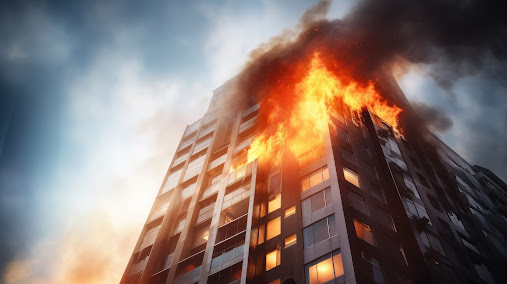Fire is a devastating force that can cause immense destruction to buildings and endanger lives. To mitigate the risks associated with fire, it is crucial to implement fire safety measures, including the use of fire-resistant materials and adherence to fire codes and regulations. One of the key aspects of fire safety is understanding the concept of fire resistance rating. Fire resistance rating refers to the duration that a building component, such as a wall, floor, or door, can withstand the effects of fire without compromising its structural integrity or spreading the fire to other areas. The rating is determined through rigorous testing procedures conducted in specialized laboratories.
Importance of Fire Resistance Rating
The primary purpose of fire resistance is to provide occupants with sufficient time to evacuate a building safely during a fire incident. By implementing fire-resistant materials and assemblies, the spread of fire and smoke can be delayed, allowing emergency response teams more time to control the situation.
Moreover, fire resistance rating plays a critical role in protecting property and minimizing damage, reducing the potential financial losses associated with fire accidents.
Factors Affecting Fire Resistance Rating
Several factors influence the fire resistance of a building component. These include the type and thickness of materials used, the structural configuration, insulation properties, and the presence of fire protection systems like sprinklers. Each of these factors plays a significant role in determining the overall fire performance of the structure.
Fire resistance rating is a measure of how well a material, structure, or assembly can withstand exposure to fire. Several factors can affect the fire rating of a particular element or system. Here are some of the key factors:
- Material Composition: The type and composition of materials used in construction play a significant role in determining fire resistance. Certain materials, such as concrete, gypsum, and mineral wool, are inherently more fire-resistant compared to wood or plastics.
- Thickness: The thickness of a material or assembly can impact its fire resistance rating. Thicker materials generally provide better insulation and are more effective at preventing the transfer of heat during a fire.
- Density: The density of a material affects its ability to absorb and retain heat. Materials with higher density, such as concrete or brick, tend to have better fire resistance properties due to their ability to absorb and dissipate heat.
- Fire-Resistant Coatings: Applying fire-resistant coatings or treatments to materials can enhance their fire resistance rating. These coatings are designed to form a protective barrier that delays the spread of fire and reduces heat transfer.
- Structural Configuration: The design and configuration of a structure or assembly can influence its fire resistance. For example, the presence of fire-resistant barriers, firestops, and compartmentalization can help prevent the spread of fire and limit its impact.
- Ventilation: The presence and design of ventilation systems can impact the fire resistance rating of a building. Properly designed ventilation can help remove smoke and heat, improving occupant safety and minimizing damage.
- Fire-Resistant Joints and Seals: Joints and seals in building assemblies can be vulnerable to fire spread. The use of fire-resistant seals, gaskets, and expansion joints can help maintain the integrity of fire-rated assemblies and prevent fire penetration.
- Installation Quality: The quality of construction and installation practices can affect the fire resistance of a structure. Proper installation of fire-rated materials, adherence to building codes, and regular maintenance can ensure that the intended fire resistance rating is achieved.
- Building Materials: The type of materials used in construction significantly impacts the fire resistance. Certain materials, such as concrete, brick, and steel, have inherent fire-resistant properties and provide better protection against fire compared to wood or plastics. The composition and thickness of these materials play a crucial role in determining their fire resistance.
- Structural Design: The structural design of the building influences its fire resistance rating. Elements like fire-rated walls, floors, and doors, along with the arrangement of compartments and firebreaks, can help contain the spread of fire and limit its impact. A well-designed building with proper fire-resistant barriers and compartmentalization can enhance its overall fire resistance.
- Fire Protection Systems: The presence and effectiveness of fire protection systems greatly impact the fire resistance rating. These systems include fire sprinklers, fire alarms, smoke detectors, and fire extinguishers. Adequate installation, maintenance, and functionality of these systems can help detect and suppress fires, minimizing their spread and damage.
- Fire Resistance of Building Components: Different components within a building, such as walls, floors, columns, and roofs, have varying fire resistance ratings. The fire resistance of these components depends on factors such as their materials, thickness, insulation, and the presence of fireproofing measures. Each component’s fire resistance contributes to the overall fire resistance of the building.
- Ventilation Systems: The design and operation of ventilation systems can impact the fire resistance rating. Properly designed ventilation can help remove smoke and heat, improving occupant safety and minimizing fire spread. However, improper ventilation can accelerate the spread of fire and smoke throughout the building.
- Occupant Load: The number of occupants in a building affects its fire resistance. Buildings designed for high occupant loads may require stricter fire safety measures to ensure the safe evacuation of occupants in the event of a fire.
- Maintenance and Upkeep: Regular maintenance and inspection of fire protection systems, building components, and fire-rated materials are essential to maintain the intended fire resistance rating. Neglecting maintenance can compromise the effectiveness of fire-resistant elements and reduce the building’s overall fire resistance.
- Compliance with Building Codes: Adherence to local building codes and regulations is crucial in determining the fire resistance rating. Building codes provide guidelines and requirements for fire safety measures, including fire-resistant construction materials, fire-rated assemblies, and installation practices. Compliance with these codes ensures that the building meets minimum fire safety standards.


No comments:
Post a Comment